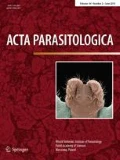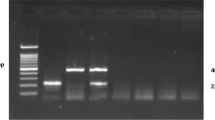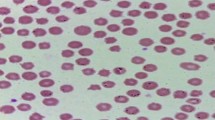Abstract
Background
Theileriosis, trypanosomosis and babesiosis are the three major haemoprotozoan diseases causing huge economic losses worldwide. Difficulty in diagnosis of these diseases lies with the detection of carrier state with low parasitemia and concurrent infection.
Purpose
The present study was conducted to standardize and evaluate multiplex PCR assay for specific, fast and simultaneous detection of Theileria annulata, Trypanosoma evansi and Babesia bovis in bovines.
Methods
Positive parasitic DNA was obtained from microscopically positive samples. Simplex PCR assay was developed targeting repetitive nucleotide sequences for Trypanosoma evansi and gene coding enzyme carbamoyl phosphate synthetase II for Babesia bovis. For theileriosis conditions already standardized targeting cytochrome b gene was used. Gradient PCR assay was used to determine common amplification conditions and develop multiplex PCR assay. Limit of detection was determined using tenfold serial dilution of parasitic DNA. Blood samples collected from 117 bovines suspected for haemoparasite infection was tested by simplex and multiplex PCR assay.
Results
Simplex PCR assay was able to detect Theileria annulata, Trypanosoma evansi and Babesia bovis at dilution 10−9, 10−8 and 10−8 which corresponds to copy number 1, 10 and 10, respectively, whereas of multiplex PCR assay was found to be 10−7 dilution corresponding to 100 copy number. PCR products bands obtained in multiplex PCR assay at 257, 312 and 446 bp were easily distinguishable. Results of simplex PCR assay for detection of individual parasites revealed 48 (41.02%), 27 (23.07%) and 5 (4.27%) samples positive for T. annulata, T. evansi and B. bovis, respectively. Sixty-three (53.8%) samples were found positive by multiplex PCR assay with 15 samples (23.8%) showing mixed infection.
Conclusion
Multiplex PCR assay was found to be highly specific and can be used for easy, early, sensitive, specific and simultaneous diagnosis of haemoprotozoan diseases in epidemiological survey as a robust tool.






Similar content being viewed by others
References
Narladkar BW (2018) Projected economic losses due to vector and vector-borne parasitic diseases in livestock of India and its significance in implementing the concept of integrated practices for vector management. Vet World 11(2):151–160. https://doi.org/10.14202/vetworld.2018.151-160
Simuunza M, Weir W, Courcier E, Tait A, Shiels B (2011) Epidemiological analysis of tick-borne diseases in Zambia. Vet Parasitol 175:331–342. https://doi.org/10.1016/j.vetpar.2010.09.027
Molad T, Mazuz ML, Fleiderovitz L, Fish L, Savitsky I, Krigel Y, Leibovitz B, Molloy J, Jongejan F, Shkap V (2006) Molecular and serological detection of A. centrale- and A. marginale-infected cattle grazing within an endemic area. Vet Microbiol 113:55–62. https://doi.org/10.1016/j.vetmic.2005.10.026
Charaya G, Rakha NK, Maan S, Kumar A, Kumar T, Jhambh R (2016) Comparative evaluation of polymerase chain reaction assay with microscopy for detection of asymptomatic carrier state of theileriosis in a herd of crossbred cattle. Vet World 9(9):1039–1042. https://doi.org/10.14202/vetworld.2016.1039-1042
Heredia A, Soriano V, Weiss SH, Bravo R, Vallejo A, Denny TN, Epstein JS, Hewlett IK (1996) Development of a multiplex PCR assay for the simultaneous detection and discrimination of HIV-1, HIV-2, HTLV-I and HTLV-II. Clin Diagn Virol 7:85–92. https://doi.org/10.1016/s0928-0197(96)00255-3
Markoulatos P, Georgopoulou A, Kotsovassilis C, Karabogia-Karaphillides P, Spyrou (2000) Detection and typing of HSV-1, HSV-2, and VZV by a multiplex polymerase chain reaction. J Clin Lab Anal 14:214–219. https://doi.org/10.1002/1098-2825(2000)14:5%3c214:aid-jcla3%3e3.0.co;2-4
Charaya G, Sharma A, Kumar A, Goel P, Singh M (2015) Detection of major mastitis pathogens by multiplex polymerase chain reaction assay in buffalo milk. Indian J Anim Sci 85:122–125
Bilgiç HB, Tü Karagenç, Simuunza M, Shiels B, Tait A, Eren H, William W (2013) Development of a multiplex PCR assay for simultaneous detection of Theileria annulata, Babesia bovis and Anaplasma marginale in cattle. Exp Parasitol 133:222–229. https://doi.org/10.1016/j.exppara.2012.11.005
Ananyutthawongese CT, Saengsombut K, Sukhumsirichat W, Uthaisang W, Sarataphan N, Chansiri K (1999) Detection of bovine hemoparasite infection using multiplex polymerase chain reaction. Sci Asia 25:85–90. http://www.scienceasia.org/1999.25.n2/v25_085_090.pdf
Gharbi M, Sassi L, Dorchies P, Darghouth MA (2006) Infection of calves with Theileria annulata in Tunisia: economic analysis and evaluation of the potential benefit of vaccination. Vet Parasitol 137:231–241. https://doi.org/10.1016/j.vetpar.2006.01.015
Henegariu O, Heerema NA, Dlouhy SR, Vance GH, Vogt PH (1997) Multiplex PCR: critical parameters and step-by-step protocol. Biotechniques 23:504–511. https://doi.org/10.2144/97233rr01
Ashuma Sharma A, Kaur P, Bal MS, Singla LD (2014) Application of multiplex PCR for the simultaneous detection of natural infection of theileriosis, babesiosis, and trypanosomosis in cattle. J Vet Parasitol 28(2):112–116
Kundave VR, Ram H, Banerjee PS, Garg R, Mahendran K, Ravikumar GVVPS, Tiwari AK (2018) Development of multiplex PCR assay for concurrent detection of tick borne haemoparasitic infections in bovines. Acta Parasitol 63:759–765. https://doi.org/10.1515/ap-2018-0090
Acknowledgements
The authors thank Professor and Head, Veterinary Medicine, College of Veterinary Sciences and Dean, College of Veterinary Sciences for the financial support provided for conducting the research.
Author information
Authors and Affiliations
Contributions
GC and NK designed the study, GC collected the samples, GC, AK and SM conducted the research and SM and PK analyzed the results. GC wrote the article and rectified it by other authors.
Corresponding author
Ethics declarations
Conflict of Interest
The authors declare that they have no conflict of interest.
Human and Animal Rights
As per guidelines of institutional ethical committee, there is no need for taking ethical permission for conducting study on clinical cases presented in Large Animal Section, Veterinary Clinical Complex as diagnosis of disease requires collection of samples. Samples collected from two farms situated in Hisar were taken on request of farm owner for diagnosis of suspected cases of haemoprotozoan diseases.
Additional information
Publisher's Note
Springer Nature remains neutral with regard to jurisdictional claims in published maps and institutional affiliations.
Rights and permissions
About this article
Cite this article
Charaya, G., Rakha, N.K., Kumar, A. et al. End Point Multiplex PCR for Diagnosis of Haemoprotozoan Diseases in Cattle. Acta Parasit. 66, 91–97 (2021). https://doi.org/10.1007/s11686-020-00259-2
Received:
Accepted:
Published:
Issue Date:
DOI: https://doi.org/10.1007/s11686-020-00259-2




